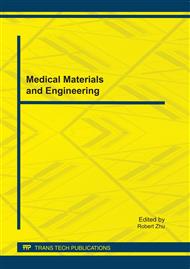p.17
p.24
p.29
p.34
p.38
p.43
p.48
p.53
p.58
Bio-Inspired Fabrication of Polymer Composite Scaffolds with Chitosan Network inside the Pore Channels
Abstract:
Solid freeform fabrication, known as rapid prototyping (RP) technology allows in designing the scaffold with pre-defined and controlled external and internal architecture.In this study we produce scaffolds with network of chitosan fibrils that mimic the extracellular matrix produced by the cells. These network scaffolds also consisting of nanoparticles of hydroxyapatite (HA) for stabilisation of scaffolds are characterised by environmental scanning electron microscopy and mechanical properties. ESEM showed that the scaffolds possess macropore (300µm), micropore and fibre network structure. The compressive strength and elastic modulus (E) for the scaffolds are 0.54± 0.02 MPa and 6.13± 0.60 MPa, respectively, which are increasing obviously. The biocompatibility of the woodpile-network scaffolds was investigated with osteoblastic cells. The result showed the distribution and proliferation of osteoblast orients along the chtosan fibre network, preferentially. After 4 weeks of culture, macropore channels are covered by cells in large part,while the areas without chitosan fibre network are covered rarely. The properties of these scaffolds indicate that they can be used for bone tissue engineering applications.
Info:
Periodical:
Pages:
38-42
Citation:
Online since:
November 2011
Authors:
Keywords:
Price:
Сopyright:
© 2012 Trans Tech Publications Ltd. All Rights Reserved
Share:
Citation:


